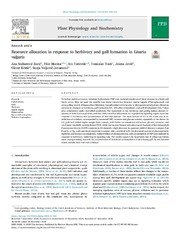| dc.creator | Sedlarević-Zorić, Ana | |
| dc.creator | Morina, Filis | |
| dc.creator | Toševski, Ivo | |
| dc.creator | Tosti, Tomislav | |
| dc.creator | Jović, Jelena | |
| dc.creator | Krstić, Oliver | |
| dc.creator | Veljović-Jovanović, Sonja | |
| dc.date.accessioned | 2019-04-04T16:07:47Z | |
| dc.date.available | 2019-04-04T16:07:47Z | |
| dc.date.issued | 2019 | |
| dc.identifier.issn | 0981-9428 | |
| dc.identifier.uri | https://plantarum.izbis.bg.ac.rs/handle/123456789/569 | |
| dc.description.abstract | Trehalose and its precursor, trehalose 6-phosphate (T6P), are essential regulators of plant response to abiotic and biotic stress. Here we used the specific host-insect interaction between Linaria vulgaris (Plantaginaceae) and stem-galling weevil, Rhinusa pilosa (Mecinini, Curculionidae) with the aim to distinguish carbohydrate allocation patterns in response to herbivory, gall formation (G1, 24 h after oviposition), and gall development (G2, 7 days after oviposition) under controlled conditions. The hypothesis is that herbivory and galling induce distinct responses in both leaves and stems, and that shifts in carbon allocations are regulated by signaling sugars. Systemic response to herbivory was accumulation of T6P and maltose. The main feature of G1 in the stems was accumulation of trehalose, accompanied by increased T6P, turanose and glucose content, oppositely to the leaves. In G2, galls had 3-folds higher weight than controls, with further accumulation of fructose, glucose, turanose, and total water-insoluble carbohydrates (TIC), while the sucrose/hexose ratio decreased. Analysis of fast chlorophyll fluorescence kinetic (OJIP) transients in G2 showed a slight decrease in quantum yield of electron transport flux from Q(A) to Q(B), and towards photosystem I acceptor side, correlated with the decreased content of photosynthetic pigments and hexoses accumulation. Redistribution of photosynthates, and accumulation of T6P were induced in response to herbivory, indicating its signaling role. The results support the hypothesis that R. pilosa can induce plant reprogramming towards the accumulation of beneficial carbohydrates in developing gall by mechanisms which include both T6P and trehalose. | en |
| dc.publisher | Issy-Les-Moulineaux : Elsevier France - Editions Scientifiques Medicales | |
| dc.relation | info:eu-repo/grantAgreement/MESTD/Integrated and Interdisciplinary Research (IIR or III)/43001/RS// | |
| dc.relation | info:eu-repo/grantAgreement/MESTD/Integrated and Interdisciplinary Research (IIR or III)/43010/RS// | |
| dc.relation | KOROLID Grant by the Ministry of Education, Youth and Sports of the Czech Republic - CZ.02.1.01/0.0/0.0/15_003/0000336 | |
| dc.relation | EU | |
| dc.rights | openAccess | |
| dc.rights.uri | https://creativecommons.org/licenses/by-nc-nd/4.0/ | |
| dc.source | Plant Physiology and Biochemistry | |
| dc.subject | Carbohydrates | en |
| dc.subject | Galls | en |
| dc.subject | Herbivory | en |
| dc.subject | Linaria vulgaris | en |
| dc.subject | Rhinusa pilosa | en |
| dc.subject | Source-sink interactions | en |
| dc.subject | Trehalose 6-phosphate | en |
| dc.title | Resource allocation in response to herbivory and gall formation in Linaria vulgaris | en |
| dc.type | article | |
| dc.rights.license | BY-NC-ND | |
| dc.citation.epage | 232 | |
| dc.citation.other | 135: 224-232 | |
| dc.citation.rank | M21 | |
| dc.citation.spage | 224 | |
| dc.citation.volume | 135 | |
| dc.type.version | publishedVersion | |
| dc.identifier.doi | 10.1016/j.plaphy.2018.11.032 | |
| dc.identifier.fulltext | https://plantarum.izbis.bg.ac.rs//bitstream/id/1648/567.pdf | |
| dc.identifier.pmid | 30578998 | |
| dc.identifier.scopus | 2-s2.0-85058646369 | |
| dc.identifier.wos | 000457659900025 | |


